Vertiport Location Selection and Optimization for Urban Air Mobility in Complex Urban Scenes
Abstract
1. Introduction
2. Problem Statement and Method Overview
2.1. Problem Statement
- (1)
- How can suitable vertiport locations be identified in complex urban areas?
- (2)
- How can optimal vertiport locations be selected to effectively meet urban demand?
2.2. Method Overview
- (1)
- Vertiport Screening Based on a Modular Grading Evaluation Index System
- (2)
- Vertiport Determination Based on a PCM-DSL Optimization Model
3. A Modular Grading Evaluation Index System
3.1. Key Evaluation Criteria for Vertiports
3.1.1. Social Attributes
- (1)
- Land Use Compatibility
- (2)
- Social Equity
- (3)
- Government Policies
- (4)
- Transport Access Conditions
3.1.2. Safety Attributes
- (1)
- Airport space requirements
- (2)
- Airport space requirements
3.1.3. Economic Attributes
- (1)
- Population Density
- (2)
- Average Rental Prices
3.2. Modular Grading Evaluation Index System
3.3. ArcGIS-Based Solution for Candidate Vertiport Selection
| Algorithm 1. Candidate site filtering based on 3D airspace constraints. |
| Data: shapefiles of 2D usable grid V2D, shapefiles of building M, shapefiles of mountains DSM, airspace requirements of Type 1 Result: locations satisfying 3D airspace requirements V3D ∅ in V2D: //Construct the pre-check 3D clearance volume construct_cuboid(center, base_length, base_height) //Build First volume with base cuboid, Second volume trapezoidal frustum construct_frustum(center, bottom_length, top_length, top_height) construct_extension( base_surface = left_boundary (top_volume), width, height, angle) //Construct Forward Slopes merge_volumes(base_volume, top_volume, forward_slope) //Combine both volumes to form the total clearance volume ORI ← 0 for deg in range (361): //Loop through 0–360° to detect any building or terrain obstructions. rotated_volume ← rotate(obstacle_volume, r) if (NOT intersects(rotated_volume, BM)) AND (NOT intersects(rotated_volume, DSM)) then: ORI ← 1 Break End For If ORI = 1 then: Append candidate l to V3D End For Return V3D |
4. A PCM-DSL Optimization Model
4.1. Model Assumptions
4.2. Notation List
4.3. Progressive Coverage Model (PCM) Incorporating Demand Satisfaction Level (DSL)
- (1)
- Facility Selection Constraint
- (2)
- Minimum Separation Distance Constraint
- (3)
- Capacity Constraint
- (4)
- Service Feasibility Constraint
- (5)
- Demand Allocation Constraint
- (6)
- Facility Selection Variable
- (7)
- Demand Satisfaction Level Variable
4.4. Hybrid Heuristic Method for Vertiport Optimization
4.4.1. Structure of the Hybrid Optimization Algorithm
| Algorithm 2. Hybrid GA–greedy–Pyomo optimization for vertiport site selection. |
| Input: Demand data, candidate vertiport data, vertiport parameters, PopulationSize, MaxGenerations, MutationRate, number of facilities to select. Output: the subset of vertiport locations, demand allocation matrix. //Step 1: Greedy Initialization Initialize empty population P ← ∅ for k = 1 to PopulationSize do Generate initial solution using greedy heuristic:
end for //Step 2: Genetic Algorithm Evolution for generation = 1 to MaxGenerations do for each solution S in population P do Fix from S Solve the Pyomo model with fixed using Gurobi to optimize Evaluate fitness(S) = total satisfied demand based on end for Select parents based on fitness (e.g., tournament or roulette selection) Apply crossover and mutation to generate offspring Update population by replacing worst-performing solutions end for //Step 3: Local Refinement Select the best solution S_best from the final population Fix from S_best Re-optimize using Pyomo and Gurobi with fixed Return final selected and optimized |
4.4.2. Algorithm Performance Verification
- (1)
- The greedy factor was set to 1. We set the number of iterations Gen to 500, the population size N to 100, the crossover probability Pc to 0.8, and the mutation probability Pm to 1. A two-point crossover operator was adopted to exchange segments of binary chromosomes representing facility selections.
- (2)
- (3)
- Following Rajendran et al. [36], the complete service distance was set to 1600 m, and the maximum service distance was set to 3000 m.
- (4)
- The minimum distance between vertiports was set to 500 m [11].
- (5)
- (6)
- The number of vertiports, denoted as H, was varied from 10 to 100 in increments of 10.
5. Case Study
5.1. Study Area and Data
5.1.1. Study Area Selection
5.1.2. Database Building
5.2. Preliminary Screening of Candidate Vertiport Locations
5.2.1. Customizing the Evaluation Index System for Shenzhen
5.2.2. Sensitivity to Evaluation Grade Adjustments
- (1)
- Safety Criteria. A comparison between Figure 14 and Figure 16a shows that safety-related indicators significantly influence the spatial distribution of candidate vertiport sites. Requirements such as helipad area and takeoff/landing procedures impose critical constraints. Under high safety standards, sites are limited to low-obstruction areas—such as water bodies, greenbelts, and transportation buffers—and are typically distant from dense residential, commercial, and office zones. In contrast, when safety requirements are relaxed, rooftops become viable locations, leading to a substantial increase in candidate sites and a shift toward areas with high human activity.
- (2)
- Economic Feasibility Criteria. A comparison of Figure 16a–c indicates that economic criteria strongly influence site selection outcomes. As economic thresholds decrease from high to medium and low, the number of candidate sites increases significantly, along with an expansion in overall service coverage. Under low economic constraints, candidate sites extend across nearly the entire study area, underscoring the regulatory role of economic feasibility in early-stage vertiport deployment.
- (3)
- Social Feasibility Criteria. Figure 16a,d,g show that social criteria also impact site selection. Shenzhen’s spatial heterogeneity—driven by topography and uneven functional zoning—produces varied suitability across districts. For example, Nanshan and Futian emphasize innovation, finance, and tourism; Luohu centers on traditional commerce; while Bao’an and Longgang focus on manufacturing and logistics, coupled with large residential populations. These functional distinctions shape how social criteria constrain candidate site distribution.
5.2.3. Region-Specific Evaluation Based on Urban Functional Zoning
5.3. Final Determination of Vertiport Locations
- (1)
- The number of iterations (Gen) was set to 700 to ensure sufficient evolutionary depth for convergence.
- (2)
- The population size (N) was increased to 150 to enhance diversity in the solution space.
- (3)
- The mutation probability (Pm) was adjusted to 0.7, balancing exploration and the preservation of high-quality genetic structures.
5.3.1. Comparison of the Results of Three Location Strategies
5.3.2. Final Location Scheme
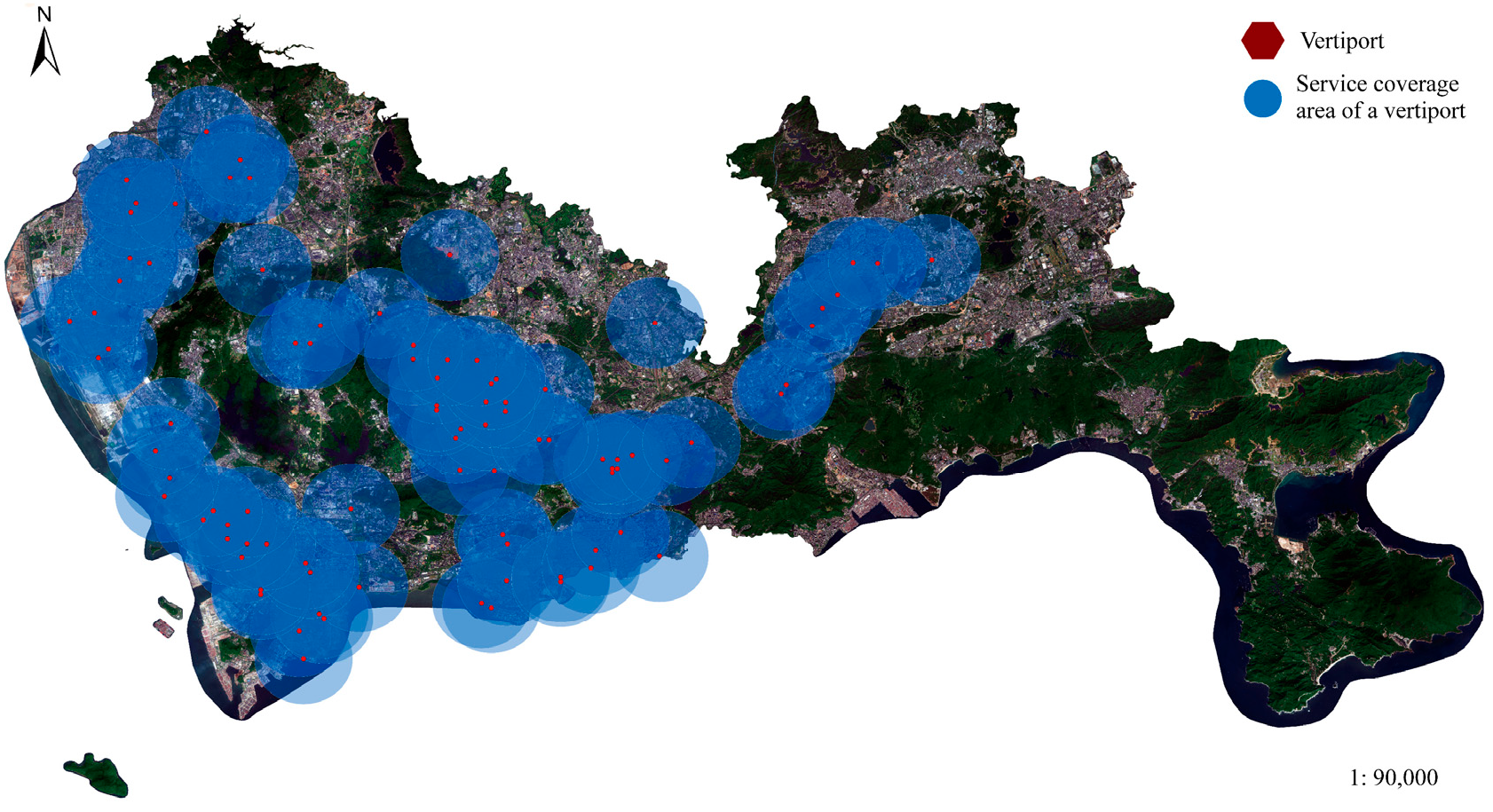
5.3.3. Sensitivity Analysis
- (1)
- Impact of travel demand
- (2)
- Impact of Maximum Vertiport Capacity
- (3)
- Impact of Vertiport Service Radius
6. Conclusions
- •
- Safety criteria exert a strong influence on vertiport land use feasibility. In regions with intense land competition, applying uniform safety standards may limit viable sites, suggesting a need for adaptive safety thresholds.
- •
- Overemphasis on economic indicators alone often results in excessive clustering of vertiports in high-value areas, which may reduce service equity and limit spatial reach.
- •
- Dividing the city into functional zones and applying differentiated evaluation indicators enhances spatial equity and leads to a more balanced vertiport distribution, thereby improving overall coverage.
- •
- While siting facilities in high-demand areas boosts coverage, it may also lead to overlapping service zones and redundancy, reducing layout efficiency.
- •
- A vertiport’s maximum service capacity significantly affects how closely facilities are clustered. Larger capacities allow for broader coverage and more dispersed deployments, whereas lower capacities require more densely packed sites.
Author Contributions
Funding
Institutional Review Board Statement
Informed Consent Statement
Data Availability Statement
Conflicts of Interest
References
- Huang, M.; Zhao, S. Tracing trajectories and co-evolution of metropolitan urbanization in the United States, Europe, and China. Sci. Total Environ. 2024, 945, 173894. [Google Scholar] [CrossRef]
- Lieberthal, E.B.; Serok, N.; Duan, J.; Zeng, G.; Havlin, S. Addressing the urban congestion challenge based on traffic bottlenecks. Philos. Trans. A 2024, 382, 20240095. [Google Scholar] [CrossRef]
- Straubinger, A.; Rothfeld, R.; Shamiyeh, M.; Büchter, K.D.; Kaiser, J.; Plötner, K.O. An overview of current research and developments in urban air mobility–Setting the scene for UAM introduction. J. Air Transp. Manag. 2020, 87, 101852. [Google Scholar] [CrossRef]
- Ellis, K.K.; Krois, P.; Koelling, J.; Prinzel, L.J.; Davies, M.; Mah, R. A Concept of Operations (ConOps) of an in-time aviation safety management system (IASMS) for Advanced Air Mobility (AAM). In Proceedings of the AIAA SciTech 2021 Forum, Nashville, TN, USA, 11–15 January 2021; p. 1978. [Google Scholar]
- Hill, B.P.; DeCarme, D.; Metcalfe, M.; Griffin, C.; Wiggins, S.; Metts, C.; Bastedo, B.; Patterson, M.D.; Mendonca, N.L. Uam Vision Concept of Operations (Conops) Uam Maturity Level (Uml) 4; NASA Technical Reports Server: Washington, DC, USA, 2020. [Google Scholar]
- Undertaking, S.J. U-space Concept of Operations, 4th ed.; Single European Sky ATM Research (SESAR) JU: Brussels, Belgium, 2023. [Google Scholar]
- Stjernberg, J.; Durnford, P.; van Egmond, P.; Krivohlavek, J.; Martijnse-Hartikka, R.; Solbø, S.A.; Wachter, F.; Wigler, K. Guidebook for Urban Air Mobility Integration–AiRMOUR Deliverable 6.4; Grano: Helsinki, Finland, 2023. [Google Scholar]
- Holden, J.; Goel, N. Fast-Forwarding to a Future of on-Demand Urban Air Transportation; Uber Technologies, Inc.: San Francisco, CA, USA, 2016. [Google Scholar]
- Schuchardt, B.I.; Becker, D.; Becker, R.-G.; End, A.; Gerz, T.; Meller, F.; Metz, I.C.; Niklaß, M.; Pak, H.; Schier-Morgenthal, S. Urban air mobility research at the DLR German aerospace center–getting the HorizonUAM project started. In Proceedings of the AIAA Aviation 2021 Forum, Washington, DC, USA, 2–6 August 2021; p. 3197. [Google Scholar]
- Seeley, B.A. Regional Sky Transit IV: Pocket Airpark Design Constraints. In Proceedings of the 17th AIAA Aviation Technology, Integration, and Operations Conference, Denver, CO, USA, 5–9 June 2017; p. 3440. [Google Scholar]
- FAA. Advisory Circular 150/5390-3—Vertiport Design (Cancelled). Available online: https://www.faa.gov/documentLibrary/media/advisory_circular/150-5390-3/150_5390_3.PDF (accessed on 1 April 2025).
- Skyports Infrastructure. Landing Infrastructure. Available online: https://skyports.net/landing-infrastructure/ (accessed on 1 April 2025).
- Johnston, T.; Riedel, R.; Sahdev, S. To Take off, Flying Vehicles First Need Places to Land; McKinsey Center for Future Mobility: New York, USA, 2020; pp. 2–8. [Google Scholar]
- Brunelli, M.; Ditta, C.C.; Postorino, M.N. New infrastructures for Urban Air Mobility systems: A systematic review on vertiport location and capacity. J. Air Transp. Manag. 2023, 112, 102460. [Google Scholar] [CrossRef]
- Murça, M.C.R. Identification and prediction of urban airspace availability for emerging air mobility operations. Transp. Res. Part C Emerg. Technol. 2021, 131, 103274. [Google Scholar] [CrossRef]
- Song, K.; Yeo, H.; Moon, J.-H. Approach control concepts and optimal vertiport airspace design for urban air mobility (UAM) operation. Int. J. Aeronaut. Space Sci. 2021, 22, 982–994. [Google Scholar] [CrossRef]
- Taylor, M.; Saldanli, A.; Park, A. Design of a vertiport design tool. In Proceedings of the 2020 Integrated Communications Navigation and Surveillance Conference (ICNS), Herndon, VA, USA, 8–10 September 2020; pp. 2A2-1–2A2-12. [Google Scholar]
- Vascik, P.D.; Hansman, R.J. Development of vertiport capacity envelopes and analysis of their sensitivity to topological and operational factors. In Proceedings of the AIAA SciTech 2019 Forum, San Diego, CA, USA, 7–11 January 2019; p. 0526. [Google Scholar]
- Fu, M.; Antoniou, C.; Rothfeld, R.; Straubinger, A. Modelling mode choice including urban air mobility–a case-study of Munich. Transp. Res. Procedia 2019, 41, 45–47. [Google Scholar] [CrossRef]
- So, J.J.; Chae, M.; Hong, J.; Youm, J.; Kim, S.H.; Kim, J. Integrated mobility hub location selection for sustainable urban mobility. Sustain. Cities Soc. 2023, 99, 104950. [Google Scholar] [CrossRef]
- Tuchen, S. Multimodal transportation operational scenario and conceptual data model for integration with UAM. In Proceedings of the 2020 Integrated Communications Navigation and Surveillance Conference (ICNS), Herndon, VA, USA, 8–10 September 2020; pp. 2C1-1–2C1-15. [Google Scholar]
- Lee, S. Prediction of urban air mobility multirotor VTOL broadband noise using UCD-QuietFly. J. Am. Helicopter Soc. 2021, 66, 1–13. [Google Scholar] [CrossRef]
- Rimjha, M.; Trani, A.; Hotle, S. Urban air mobility: Preliminary noise analysis of commuter operations. In Proceedings of the AIAA Aviation 2021 Forum, Washington, DC, USA, 2–6 August 2021; p. 3204. [Google Scholar]
- Babetto, L.; Kirste, A.; Deng, J.; Husemann, M.; Stumpf, E. Adoption of the Urban Air Mobility System: Analysis of technical, legal and social aspects from a European perspective. J. Air Transp. Res. Soc. 2023, 1, 152–174. [Google Scholar] [CrossRef]
- Al Haddad, C.; Chaniotakis, E.; Straubinger, A.; Plötner, K.; Antoniou, C. Factors affecting the adoption and use of urban air mobility. Transp. Res. Part A Policy Pract. 2020, 132, 696–712. [Google Scholar] [CrossRef]
- Chancey, E.T.; Politowicz, M.S. Public trust and acceptance for concepts of remotely operated Urban Air Mobility transportation. In Proceedings of the Proceedings of the Human Factors and Ergonomics Society Annual Meeting, Online, 5–9 October 2020; pp. 1044–1048. [Google Scholar]
- Gao, Z.; Yu, Y.; Wei, Q.; Topcu, U.; Clarke, J.-P. Noise-aware and equitable urban air traffic management: An optimization approach. Transp. Res. Part C Emerg. Technol. 2024, 165, 104740. [Google Scholar] [CrossRef]
- Goyal, R.; Reiche, C.; Fernando, C.; Serrao, J.; Kimmel, S.; Cohen, A.; Shaheen, S. Urban Air Mobility (UAM) Market Study; NASA Urban Air Mobility: Washington, DC, USA, 2018. [Google Scholar]
- Zhao, Y.; Feng, T. Commuter choice of UAM-friendly neighborhoods. Transp. Res. Part A Policy Pract. 2025, 192, 104338. [Google Scholar] [CrossRef]
- Mercan, T.; Yavas, V.; Can, D.; Mercan, Y. Vertiport location selection criteria for urban air mobility. J. Air Transp. Manag. 2025, 124, 102760. [Google Scholar] [CrossRef]
- Preis, L. Quick sizing, throughput estimating and layout planning for VTOL aerodromes–a methodology for vertiport design. In Proceedings of the AIAA Aviation 2021 Forum, Washington, DC, USA, 2–6 August 2021; p. 2372. [Google Scholar]
- Feldhoff, E.; Soares Roque, G. Determining infrastructure requirements for an air taxi service at Cologne Bonn Airport. CEAS Aeronaut. J. 2021, 12, 821–833. [Google Scholar] [CrossRef]
- Fadhil, D.N. A GIS-Based Analysis for Selecting Ground Infrastructure Locations for Urban Air Mobility. Master’s Thesis, Technical University of Munich, Munich, Germany, 2018. [Google Scholar]
- Brunelli, M.; Ditta, C.C.; Postorino, M.N. A framework to develop urban aerial networks by using a digital twin approach. Drones 2022, 6, 387. [Google Scholar] [CrossRef]
- Lim, E.; Hwang, H. The selection of vertiport location for on-demand mobility and its application to Seoul metro area. Int. J. Aeronaut. Space Sci. 2019, 20, 260–272. [Google Scholar] [CrossRef]
- Rajendran, S.; Zack, J. Insights on strategic air taxi network infrastructure locations using an iterative constrained clustering approach. Transp. Res. Part E Logist. Transp. Rev. 2019, 128, 470–505. [Google Scholar] [CrossRef]
- Guo, T.; Wu, H.; Zame, S.I.; Antoniou, C. Data-driven vertiport siting: A comparative analysis of clustering methods for Urban Air Mobility. J. Urban Mobil. 2025, 7, 100117. [Google Scholar] [CrossRef]
- Rath, S.; Chow, J.Y. Air taxi skyport location problem with single-allocation choice-constrained elastic demand for airport access. J. Air Transp. Manag. 2022, 105, 102294. [Google Scholar] [CrossRef]
- Shin, H.; Lee, T.; Lee, H.-R. Skyport location problem for urban air mobility system. Comput. Oper. Res. 2022, 138, 105611. [Google Scholar] [CrossRef]
- Kitthamkesorn, S.; Chen, A. Maximum capture problem for urban air mobility network design. Transp. Res. Part E Logist. Transp. Rev. 2024, 187, 103569. [Google Scholar] [CrossRef]
- Jiang, Y.; Li, Z.; Wang, Y.; Xue, Q. Vertiport location for eVTOL considering multidimensional demand of urban air mobility: An application in Beijing. Transp. Res. Part A Policy Pract. 2025, 192, 104353. [Google Scholar] [CrossRef]
- Wu, H.; Zame, S.I.; Guo, T.; Lu, Q.-L.; Antoniou, C. A sustainable multi-objective framework for multi-phased, capacitated vertiport siting with land use integration. Commun. Transp. Res. 2025, 5, 100186. [Google Scholar] [CrossRef]
- Jin, Z.; Ng, K.K.; Zhang, C. Robust optimisation for vertiport location problem considering travel mode choice behaviour in urban air mobility systems. J. Air Transp. Res. Soc. 2024, 2, 100006. [Google Scholar] [CrossRef]
- Willey, L.C.; Salmon, J.L. A method for urban air mobility network design using hub location and subgraph isomorphism. Transp. Res. Part C Emerg. Technol. 2021, 125, 102997. [Google Scholar] [CrossRef]
- Yap, J.Y.L.; Ho, C.C.; Ting, C.-Y. A systematic review of the applications of multi-criteria decision-making methods in site selection problems. Built Environ. Proj. Asset Manag. 2019, 9, 548–563. [Google Scholar] [CrossRef]
- Hancer, E.; Xue, B.; Zhang, M. A survey on feature selection approaches for clustering. Artif. Intell. Rev. 2020, 53, 4519–4545. [Google Scholar] [CrossRef]
- Schweiger, K.; Preis, L. Urban Air Mobility: Systematic Review of Scientific Publications and Regulations for Vertiport Design and Operations. Drones 2022, 6, 179. [Google Scholar] [CrossRef]
- Pelegrín, M.; d’Ambrosio, C.; Delmas, R.; Hamadi, Y. Urban air mobility: From complex tactical conflict resolution to network design and fairness insights. Optim. Methods Softw. 2023, 38, 1311–1343. [Google Scholar] [CrossRef]
- Chamberlain, B.; Samavatekbatan, A.; Park, H.; Gholami, S.; Lee, D.H.; Uddin, K.; Hall, K. Feasibility of Vertiport Siting and Land Use Planning: A Guide for the Process of Planning UAV/UAM Vertiport Locations; Utah. Dept. of Transportation. Division of Research: Salt Lake City, UT, USA, 2025. [Google Scholar]
- Gonzalez, C.J.D. Rooftop-Place Suitability Analysis for Urban Air Mobility Hubs: A Gis and Neural Network Approach. Master’s Thesis, Universidade NOVA de Lisboa, Lisbon, Portugal, 2020. [Google Scholar]
- Long, Q.; Ma, J.; Jiang, F.; Webster, C.J. Demand analysis in urban air mobility: A literature review. J. Air Transp. Manag. 2023, 112, 102436. [Google Scholar] [CrossRef]
- Mendonca, N.; Murphy, J.; Patterson, M.D.; Alexander, R.; Juarex, G.; Harper, C. Advanced air mobility vertiport considerations: A list and overview. In Proceedings of the AIAA Aviation 2022 Forum, Chicago, IL, USA, 27 June–1 July 2022; p. 4073. [Google Scholar]
- Rahman, B.; Bridgelall, R.; Habib, M.F.; Motuba, D. Integrating urban air mobility into a public transit system: A GIS-based approach to identify candidate locations for vertiports. Vehicles 2023, 5, 1803–1817. [Google Scholar] [CrossRef]
- EASA. Second Publication of Proposed Means of Compliance with the Special Condition VTOL. Available online: https://www.easa.europa.eu/downloads/128938/en (accessed on 1 April 2025).
- EASA. Vertiports Prototype Technical Specifications for the Design of VFR Vertiports for Operation with Manned VTOL-Capable Aircraft Certified in the Enhanced Category (PTS-VPT-DSN). Available online: https://www.easa.europa.eu/downloads/136259/en (accessed on 1 April 2025).
- ICAO. Annex 14-Aerodromes-Volume II-Heliports; ICAO: Montreal, QC, Canada, 2013. [Google Scholar]
- Seeley, B.A. Regional Sky Transit II. In Proceedings of the 16th AIAA Aviation Technology, Integration, and Operations Conference, Washington, DC, USA, 13–17 June 2016. [Google Scholar] [CrossRef]
- Seeley, B.A. Regional Sky Transit III: The Primacy of Noise. In Proceedings of the 55th AIAA Aerospace Sciences Meeting, Grapevine, TX, USA, 9–13 January 2017; pp. 1–30. [Google Scholar] [CrossRef]
- Seeley, B.A. Regional Sky Transit. In Proceedings of the 15th AIAA Aviation Technology, Integration, and Operations Conference, Dallas, TX, USA, 22-26 June 2015; pp. 1–14. [Google Scholar] [CrossRef]
- Elevate Summit. Vertiport Infrastructure Development [Video File]. 2017. Available online: https://www.youtube.com/watch?v=k3nP0F5Mzw8 (accessed on 1 April 2025).
- Syed, N.; Rye, M.; Ade, M.; Trani, A.; Hinze, N.; Swingle, H.; Smith, J.C.; Dollyhigh, S.; Marien, T. Preliminary considerations for ODM air traffic management based on analysis of commuter passenger demand and travel patterns for the Silicon Valley Region of California. In Proceedings of the 17th AIAA Aviation Technology, Integration, and Operations Conference, Denver, CO, USA, 5–9 June 2017; p. 3082. [Google Scholar]
- Vascik, P.D.; Hansman, R.J. Evaluation of key operational constraints affecting on-demand mobility for aviation in the Los Angeles basin: Ground infrastructure, air traffic control and noise. In Proceedings of the 17th AIAA Aviation Technology, Integration, and Operations Conference, Denver, CO, USA, 5–9 June 2017; p. 3084. [Google Scholar]
- Antcliff, K.R.; Moore, M.D.; Goodrich, K.H. Silicon valley as an early adopter for on-demand civil VTOL operations. In Proceedings of the 16th AIAA Aviation Technology, Integration, and Operations Conference, Washington, DC, USA, 13–17 June 2016; p. 3466. [Google Scholar]
- FAA. Concepts of Operations, Foundational Principles, Roles and Responsibilities, Scenarios and Operational Threads, Unmanned Aircraft Systems (UAS) Traffic Management (UTM) Concept of Operations, V2.0 ed; FAA: Washington, DC, USA, 2020. [Google Scholar]
- Smerk, G.M. Urban Transit: Operations, Planning and Economics. Transp. J. 2006, 45, 74–76. [Google Scholar] [CrossRef]
- Johnson, C. Key Factors in Vertiport Site Selection for Megapolitan Regions. Ph.D. Thesis, The Ohio State University, Columbus, OH, USA, 2023. [Google Scholar]
- Fu, M.; Straubinger, A.; Schaumeier, J. Scenario-based demand assessment of urban air mobility in the greater munich area. J. Air Transp. 2022, 30, 125–136. [Google Scholar] [CrossRef]
- Li, J.; Yang, R.; Li, C.; Zhou, Y.; Huang, L. Initial Research on The Vertiport for The Urban Air Mobility. In Proceedings of the Proceedings of the 2nd International Conference on Information, Control and Automation (ICICA 2022), Chongqing, China, 2–4 December 2022. [Google Scholar]
- Wei, W.; Rohrmeier, K.; Martinez, T.; Winans, M.; Park, H. Land Use Analysis on Vertiports Based on a Case Study of the San Francisco Bay Area; Mineta Transportation Institute: San Jose, VA, USA, 2023. [Google Scholar]
- FAA. Engineering Brief No. 105A, Vertiport Design. 2024. Available online: https://www.faa.gov/airports/engineering/engineering_briefs/drafts (accessed on 1 April 2025).
- Xu, J.; Murray, A.T.; Church, R.L.; Wei, R. Service allocation equity in location coverage analytics. Eur. J. Oper. Res. 2023, 305, 21–37. [Google Scholar] [CrossRef]
- Eiselt, H.; Marianov, V. Gradual location set covering with service quality. Socio-Econ. Plan. Sci. 2009, 43, 121–130. [Google Scholar] [CrossRef]
- Rimjha, M.; Trani, A. Urban air mobility: Factors affecting vertiport capacity. In Proceedings of the 2021 Integrated Communications Navigation and Surveillance Conference (ICNS), Online, 20–22 April 2021; pp. 1–14. [Google Scholar]
- Shenzhen Bureau of Statistics. Shenzhen Statistical Yearbook (2024); China Statistics Press: Beijing, China, 2024. [Google Scholar]
- Coppola, P.; De Fabiis, F.; Silvestri, F. Urban Air Mobility demand forecasting: Modeling evidence from the case study of Milan (Italy). Eur. Transp. Res. Rev. 2025, 17, 2. [Google Scholar] [CrossRef]
- Coppola, P.; Fabiis, F.D.; Silvestri, F. Urban Air Mobility Passengers’ Profiling: Evidence from Milan Airports, Italy. Transp. Res. Rec. 2025, 2679, 129–141. [Google Scholar] [CrossRef]
- Qu, W.; Huang, J.; Li, C.; Liao, X. A demand forecasting model for urban air mobility in Chengdu, China. Green Energy Intell. Transp. 2024, 3, 100173. [Google Scholar] [CrossRef]
- Ahmed, F.; Memon, M.A.; Rajab, K.; Alshahrani, H.; Abdalla, M.E.; Rajab, A.; Houe, R.; Shaikh, A. Demand prediction for urban air mobility using deep learning. PeerJ Comput. Sci. 2024, 10, e1946. [Google Scholar] [CrossRef]

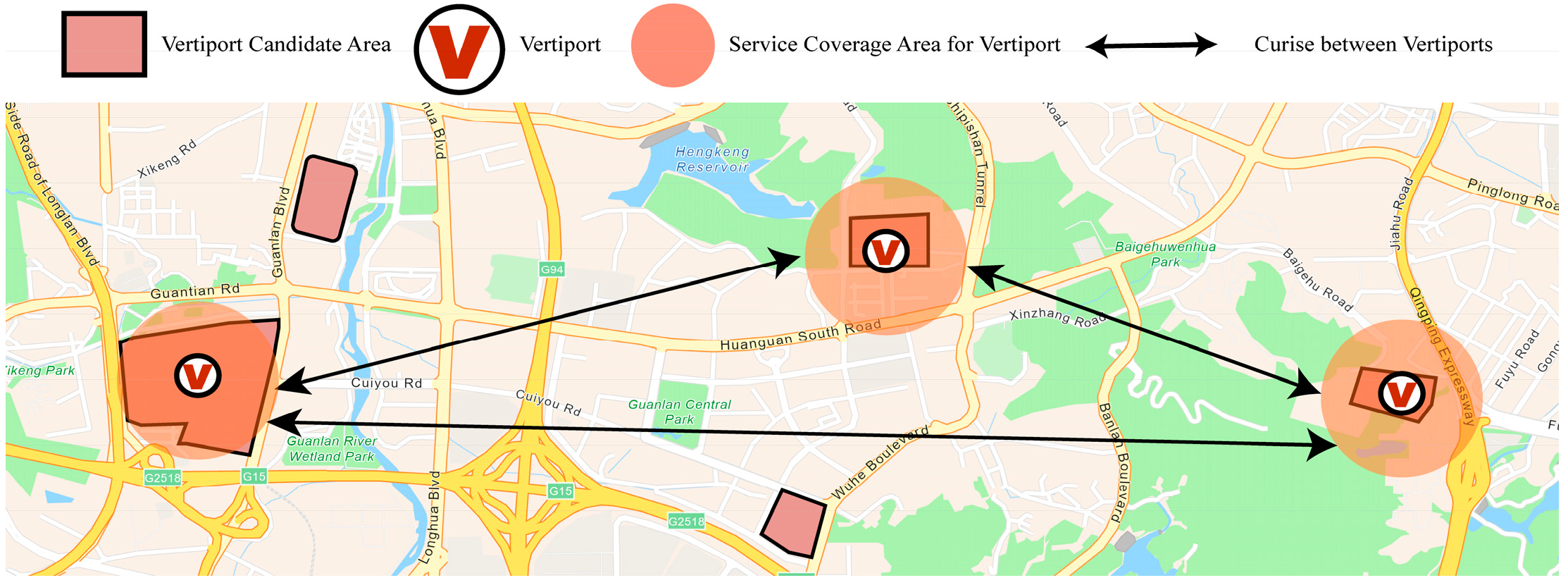



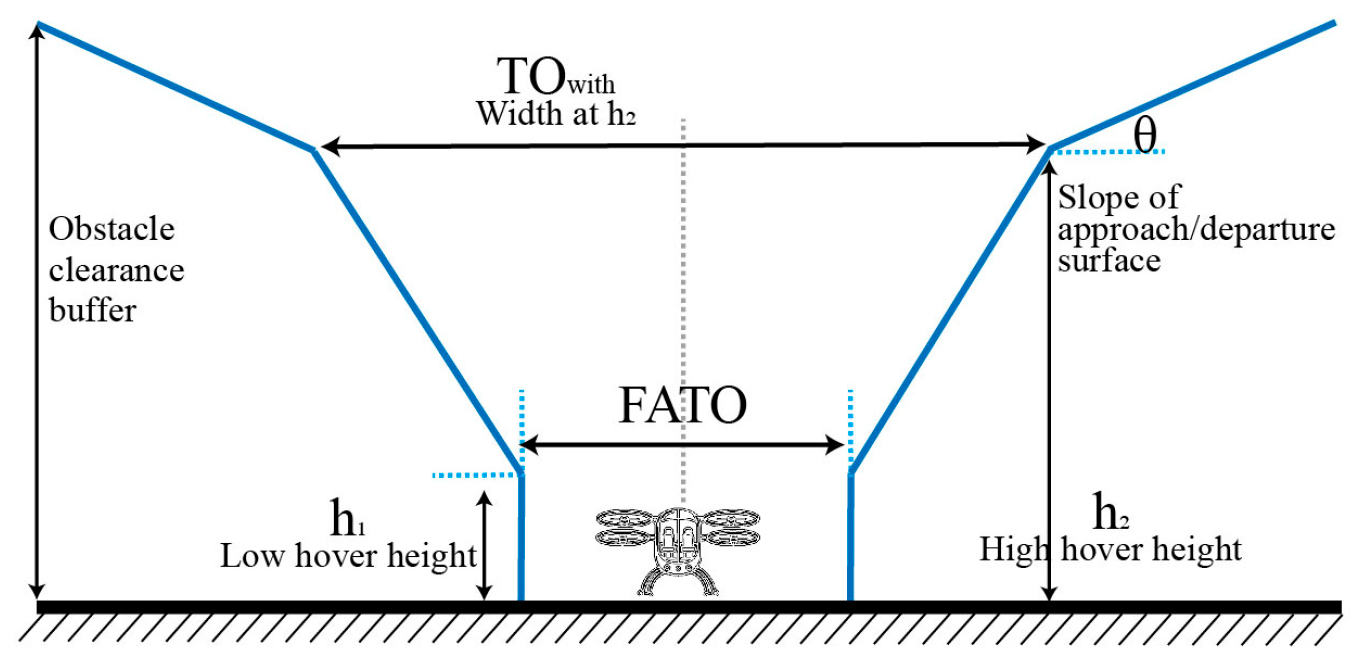
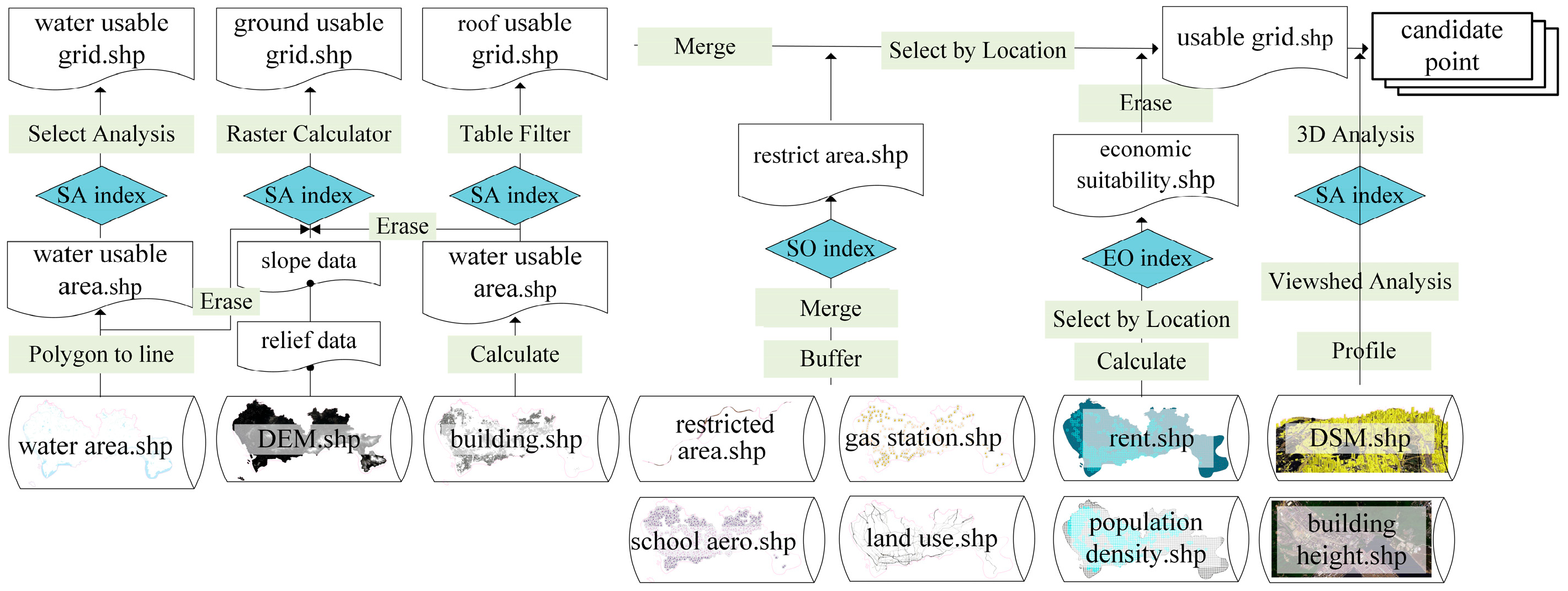

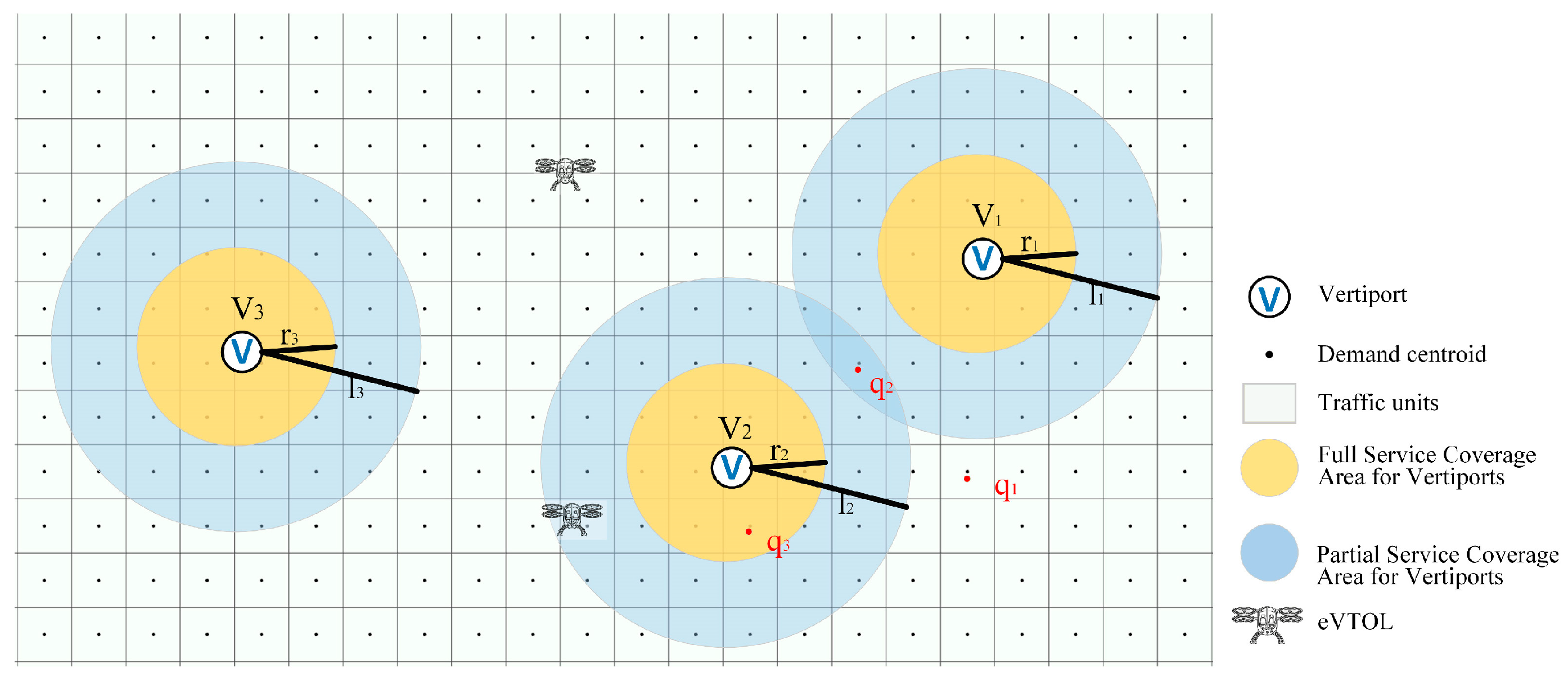
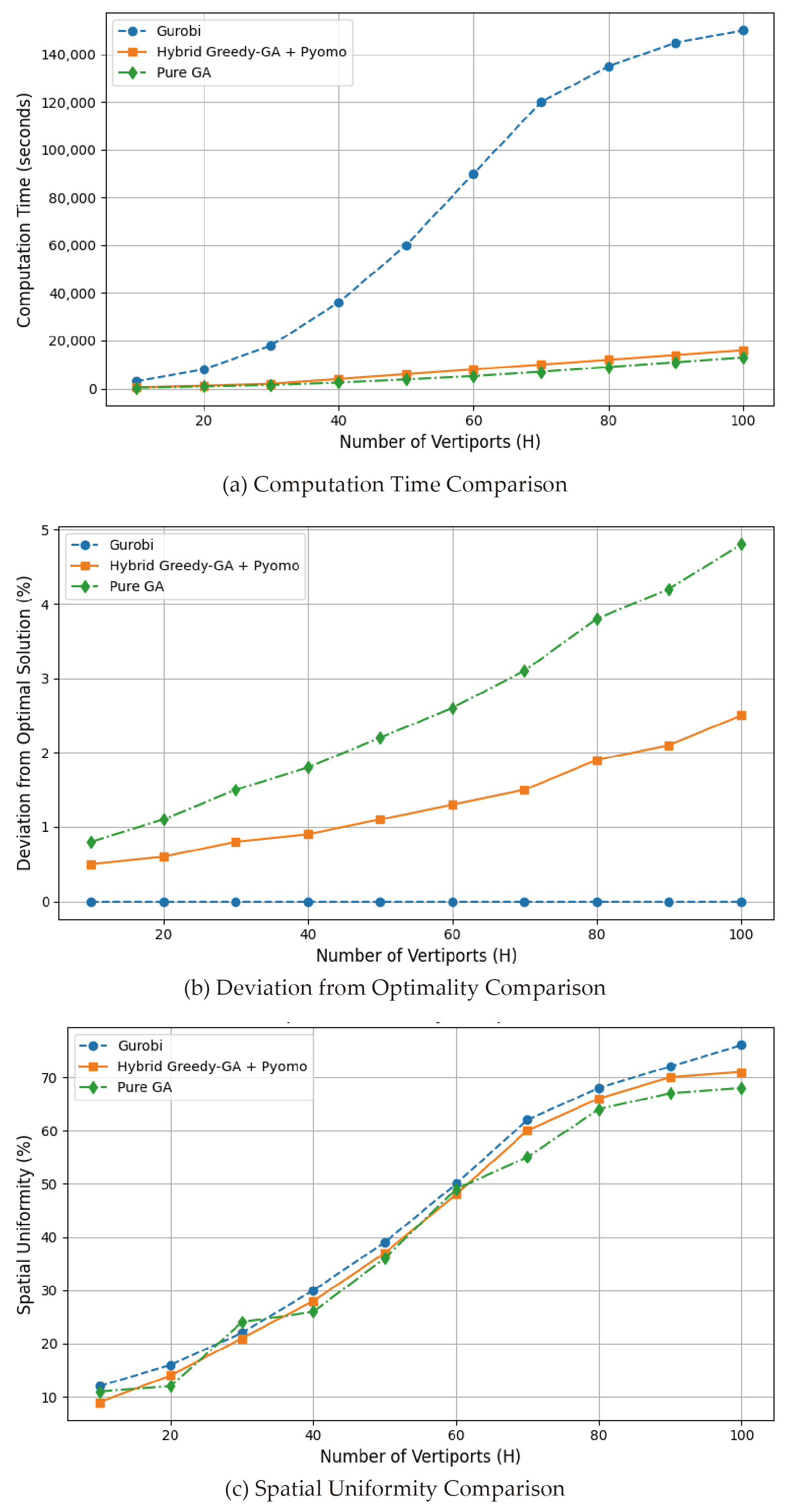

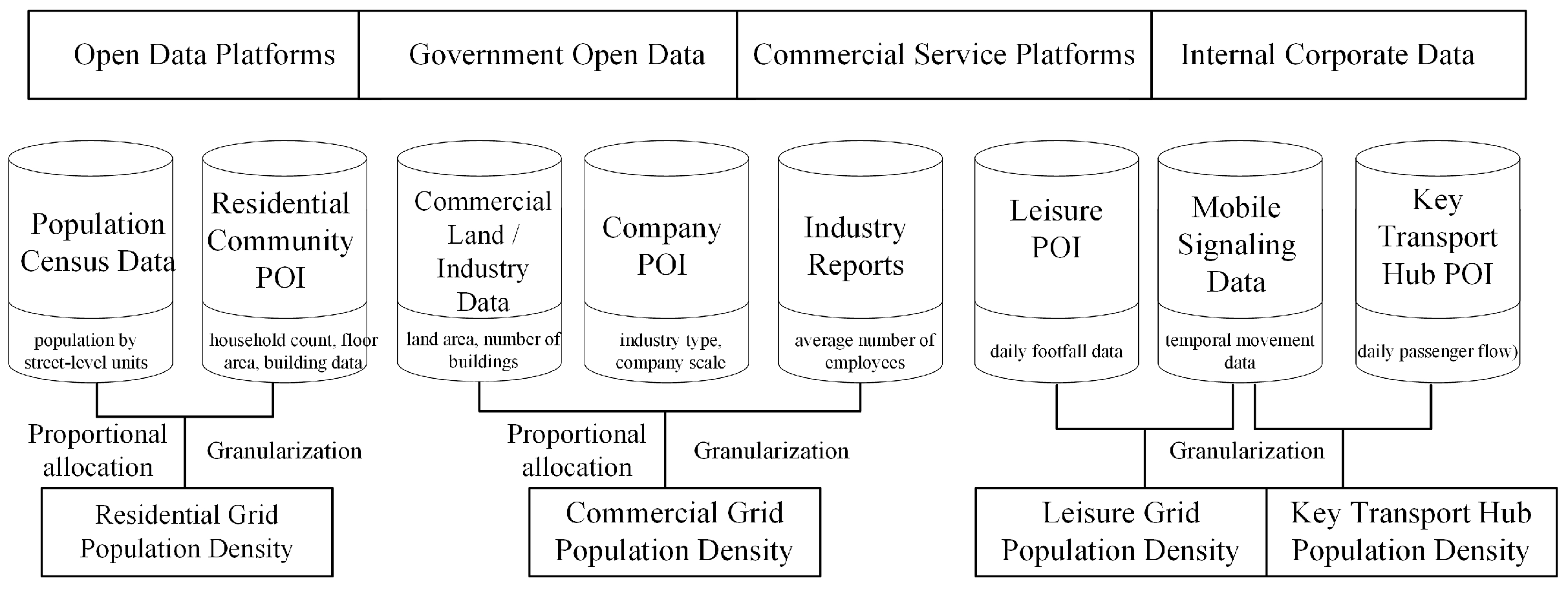

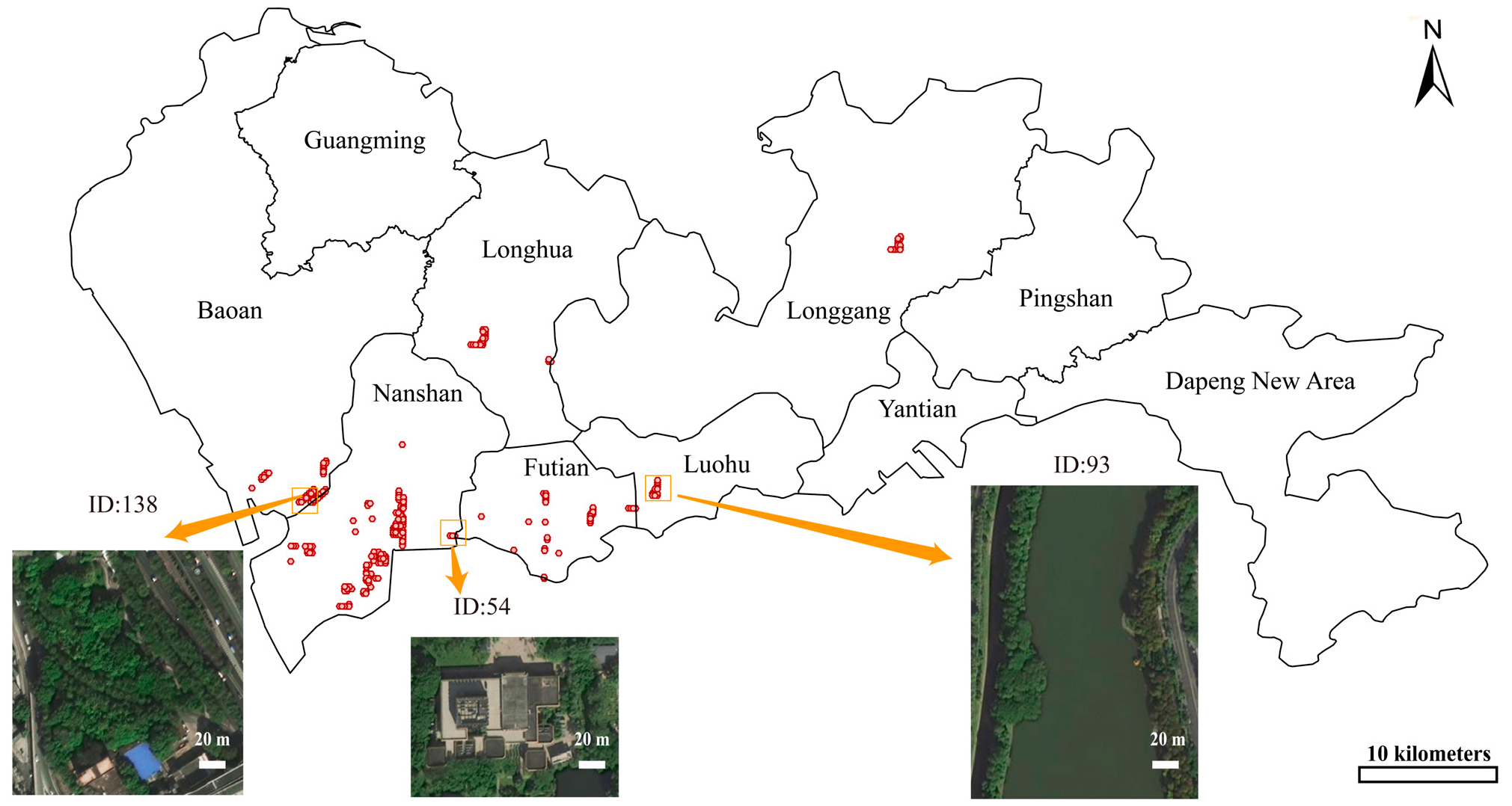

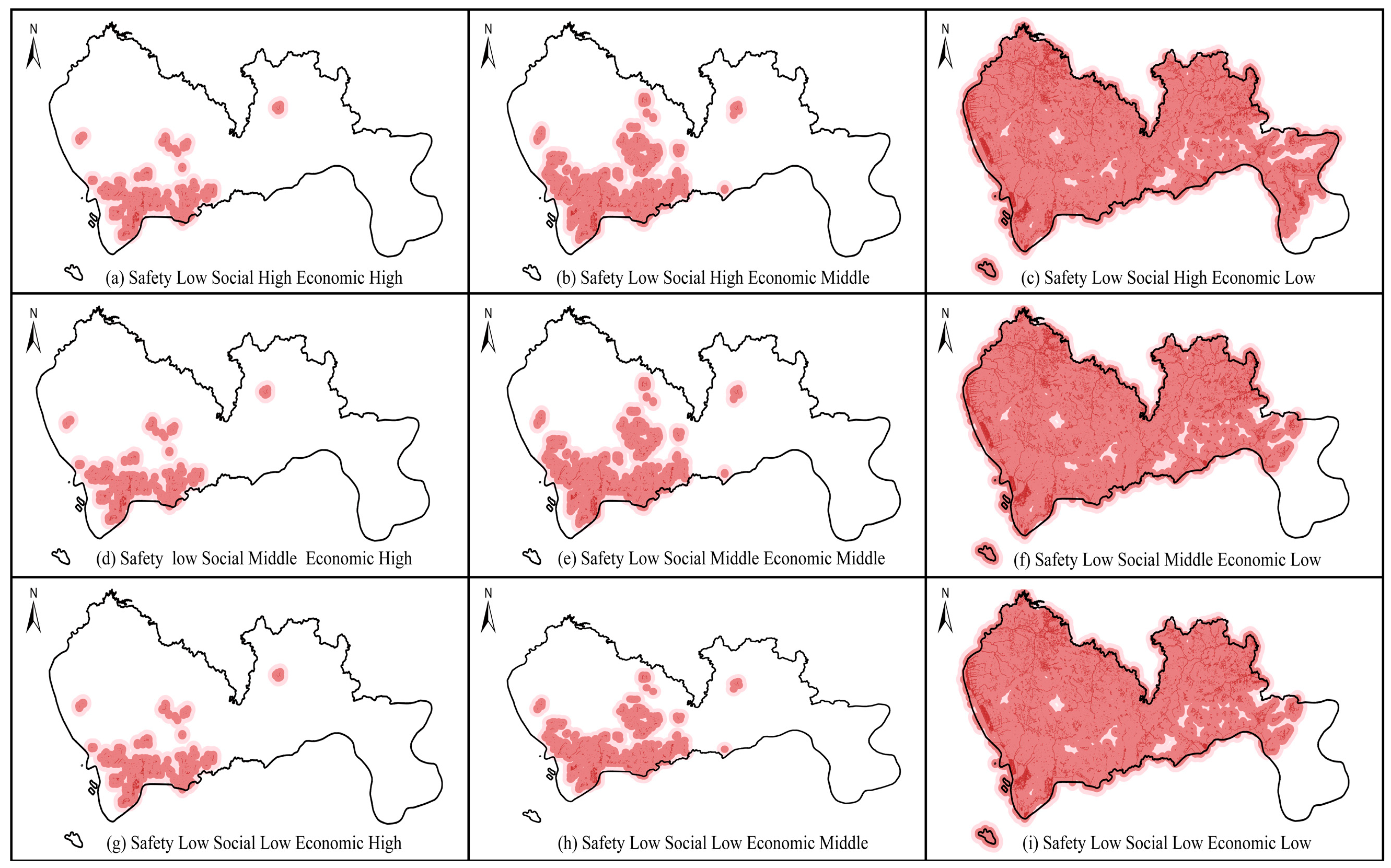
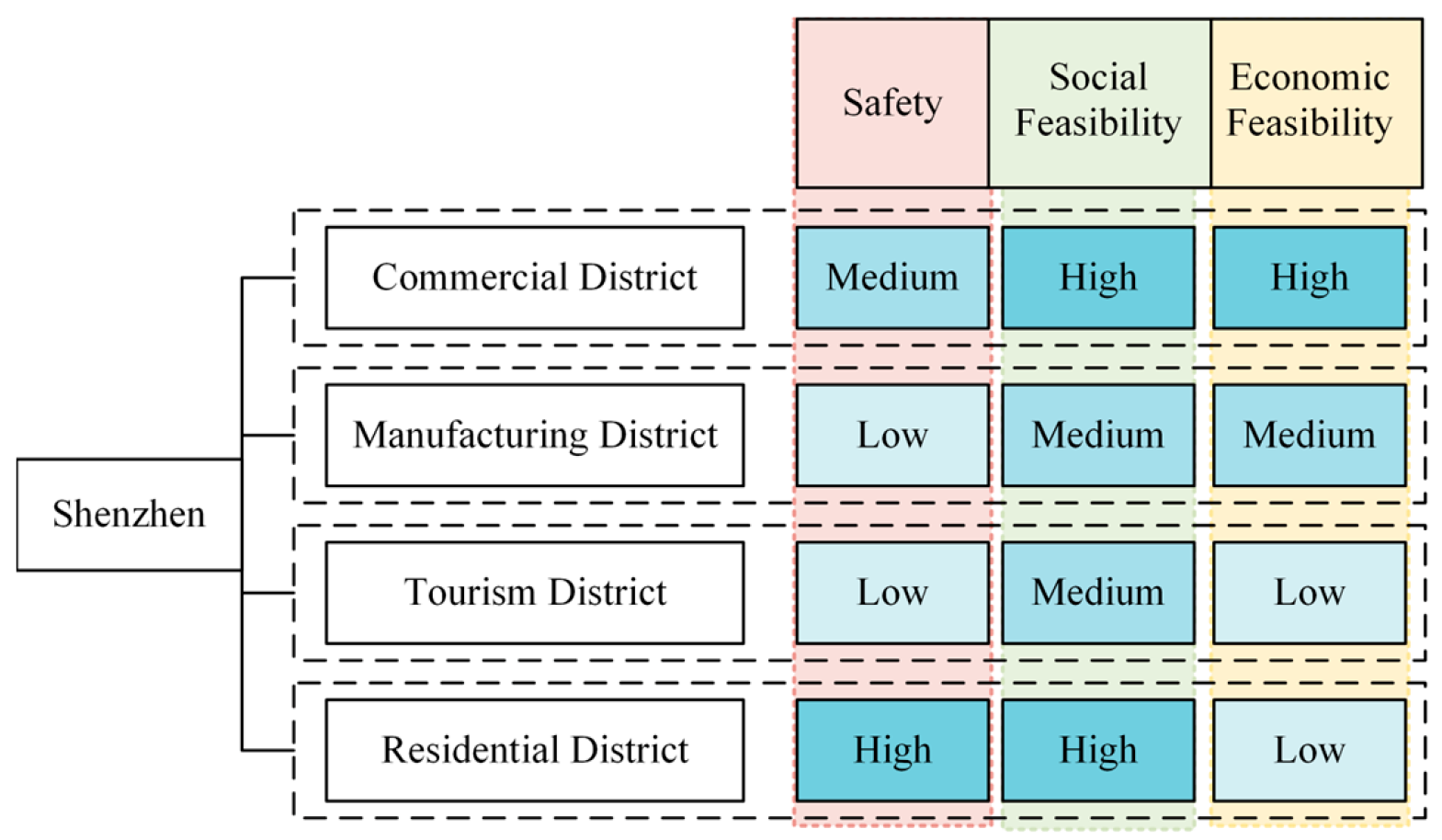
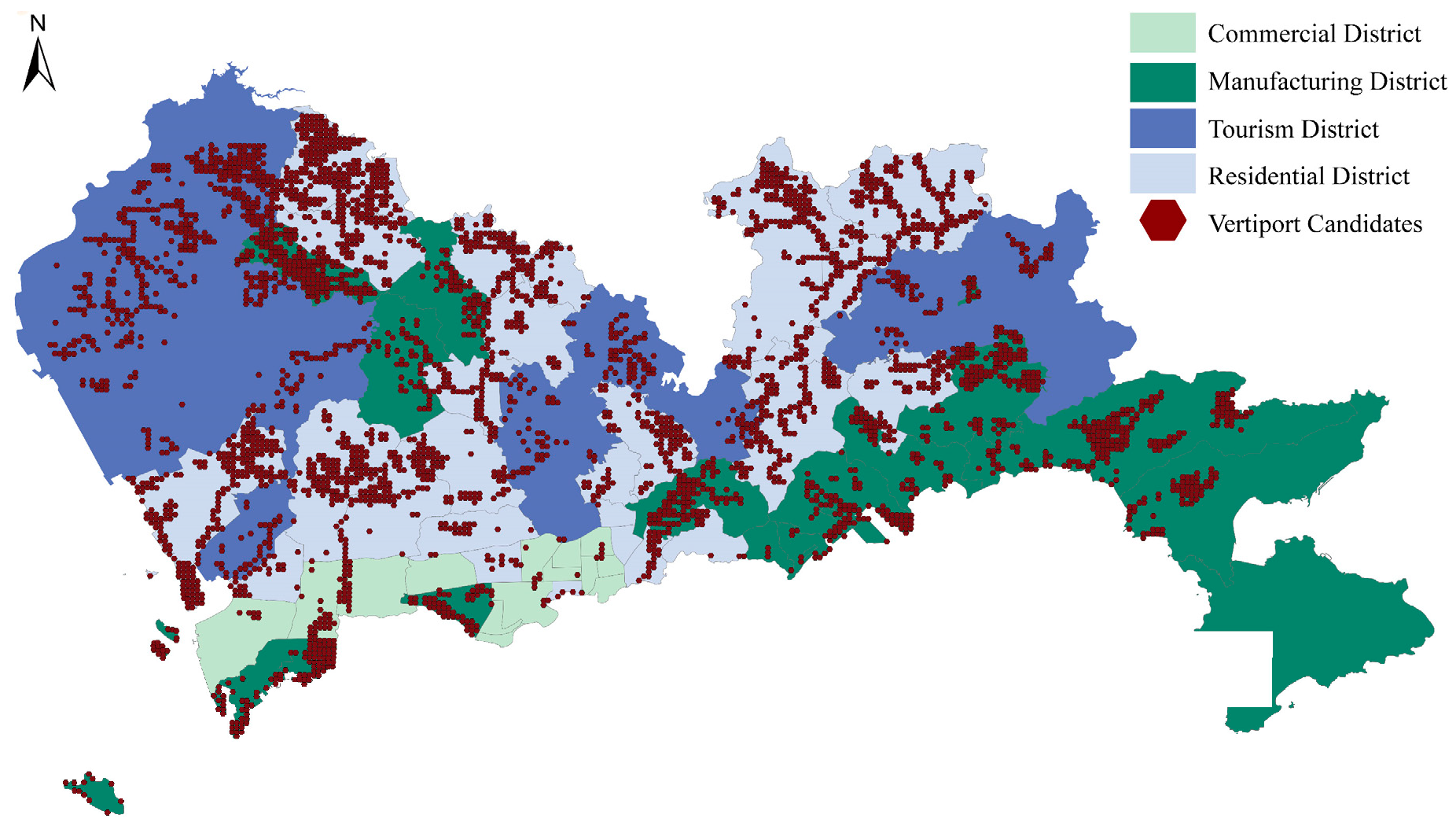
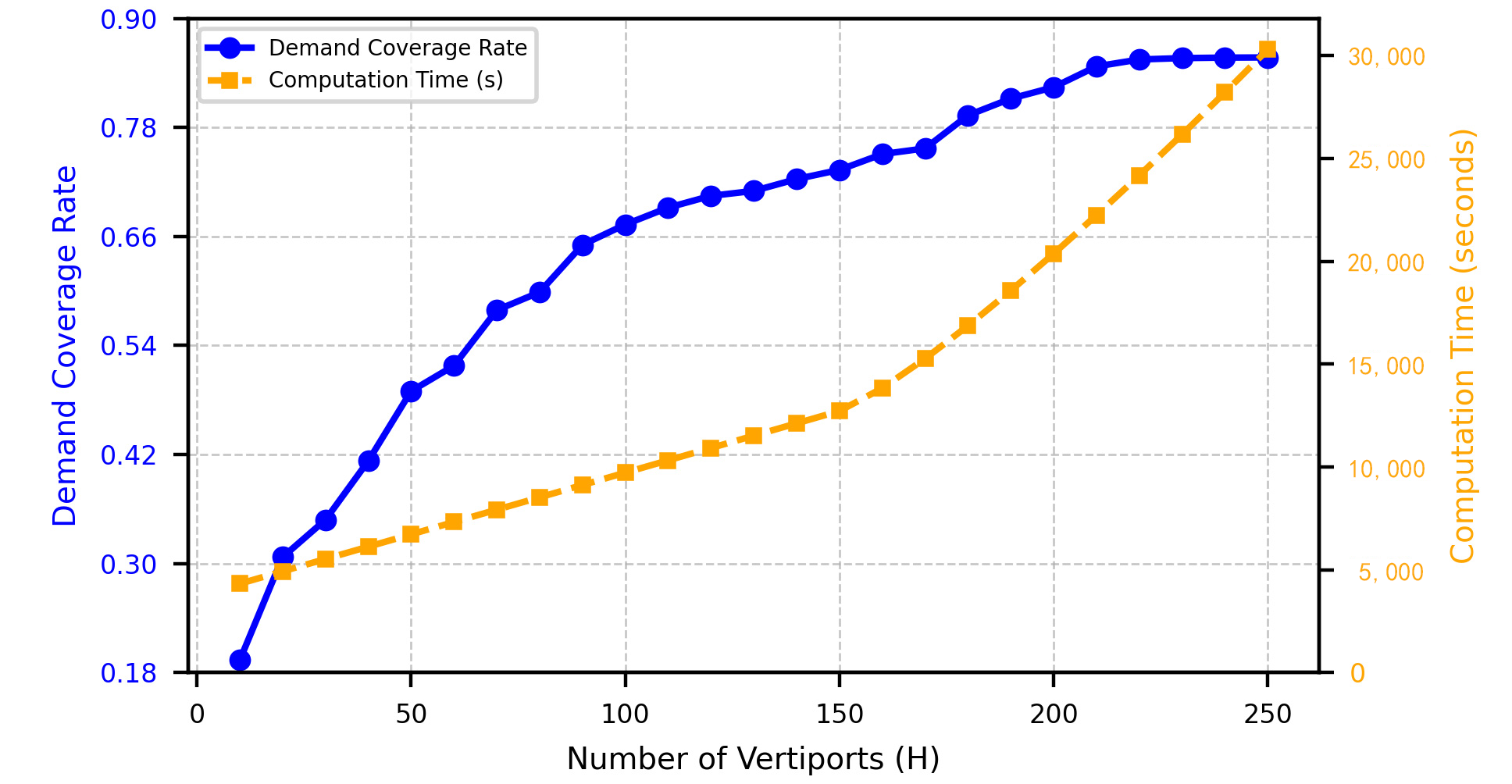
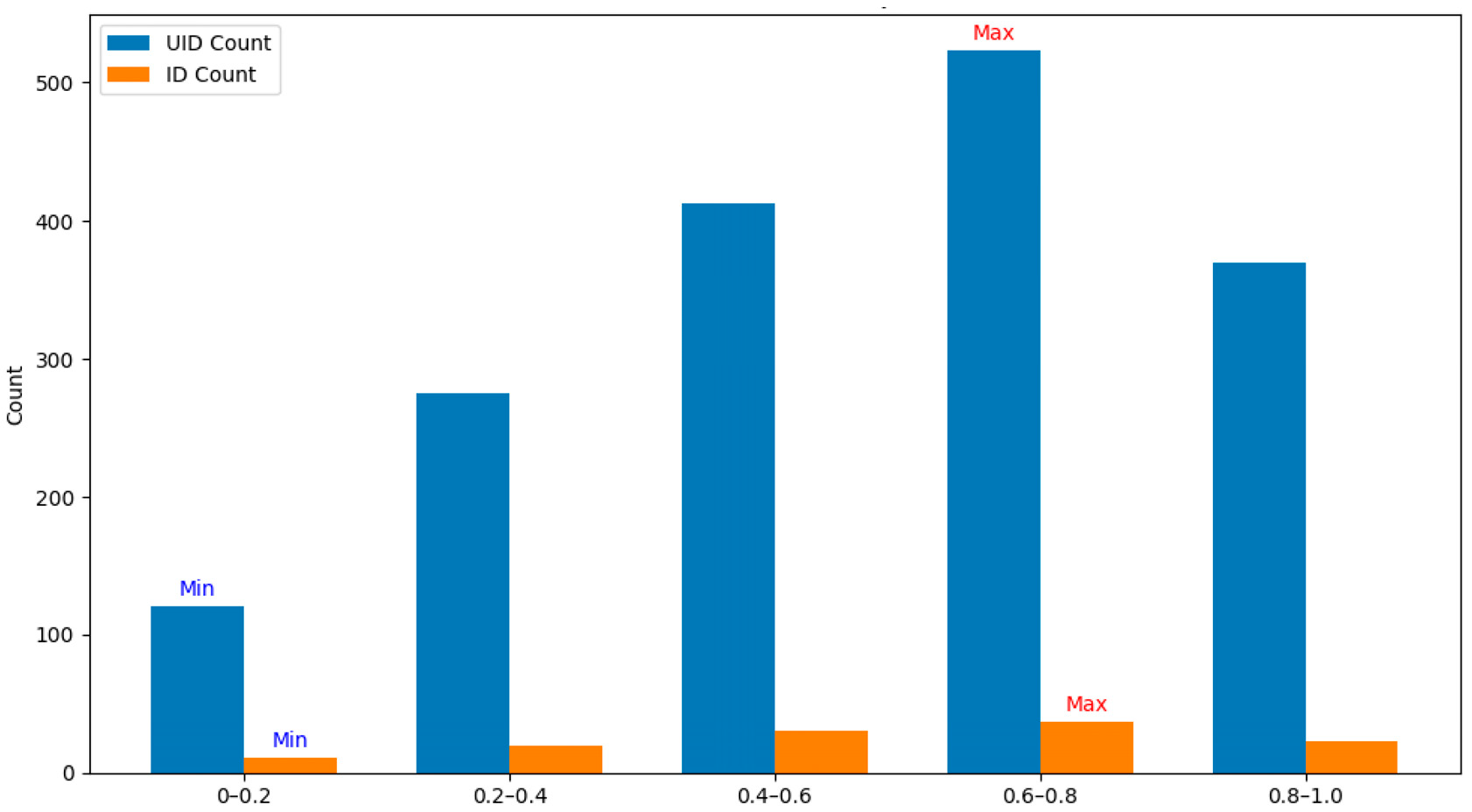
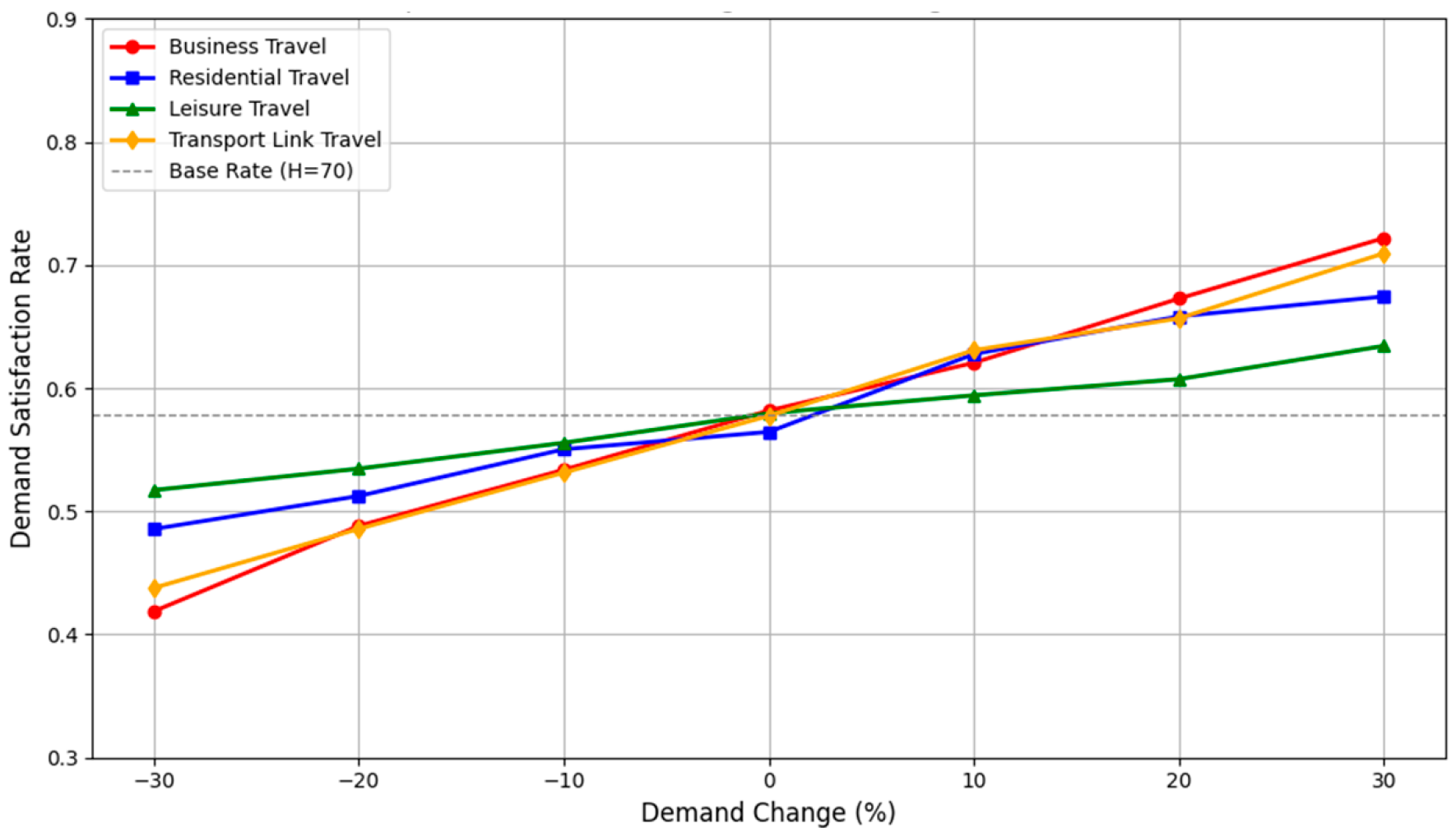
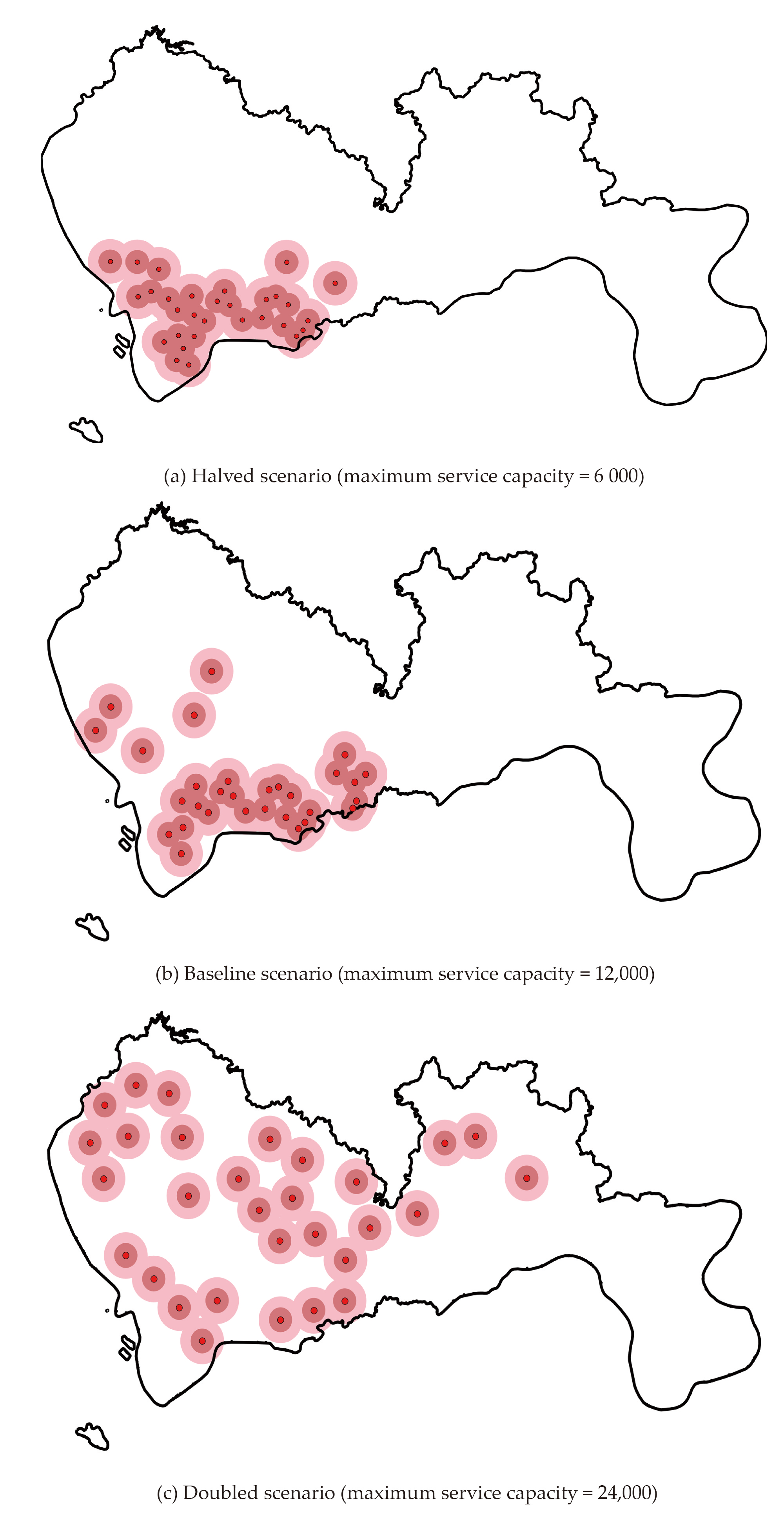
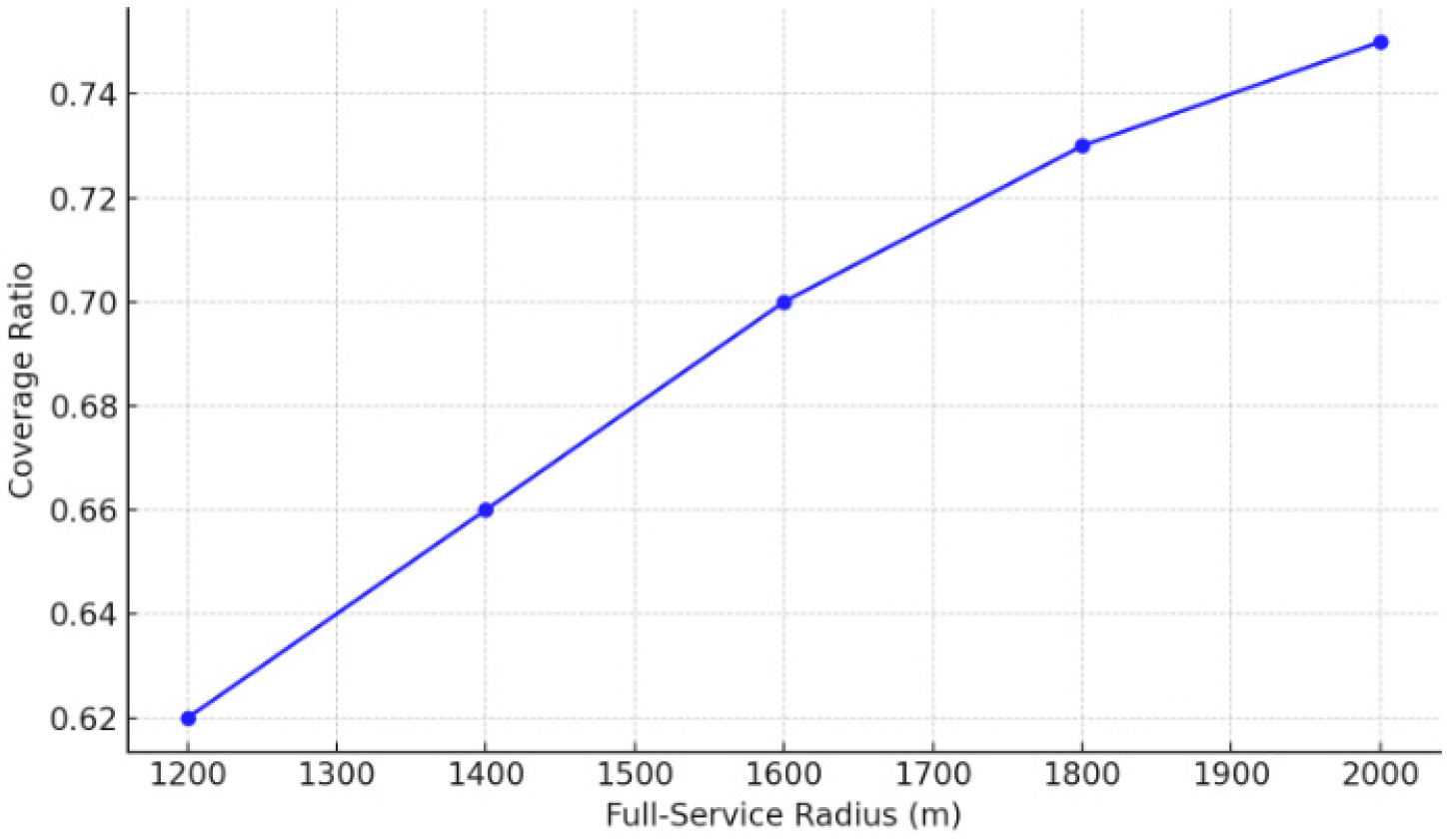
| eVTOL Vehicle | Span (m) | Cruise Speed (km/h) | Range (km) | Max Takeoff Weight (kg) | Capacity | Noise Level (dBA) | Charging Time (min) | Manufacturer |
|---|---|---|---|---|---|---|---|---|
| Airbus Vahana | 6.25 | 200 | 50 | 815 | 1-seater | — | — | Airbus (USA) |
| Lilium Jet | 10 | 280 | 250 | 3175 | 6-seater | — | ~45 | Lilium GmbH (Germany) |
| Joby S4 | 13.1 | 322 | 241.4 | 1815 | 4-seater | ~45.2–65 | — | Joby Aviation (USA) |
| SkyDrive SD-03 | 4 | 100 | 15 | 500 | 2-seater | — | — | SkyDrive Inc. (Japan) |
| Vertical Aerospace VA | 13.5 | 241 | 161 | 450 | 4-seater | ~50 | ~60 | Vertical Aerospace Ltd. (UK) |
| EHang 216 | 5.6 | 100 | 35 | 360 | 1-seater | ~70–85 | ~40–120 | EHang Holdings Ltd. (China) |
| Volocopter 2X | 9.15 | 102 | 27 | 450 | 2-seater | ~65 | ~40–120 | Volocopter GmbH (Germany) |
| Archer Aviation Maker | 12.2 | 150 | 60 | 1497 | 2-seater | ~45 | — | Archer Aviation Inc. (USA) |
| Beta Technologies ALIA-250 | 15.24 | 270 | 250 | 3175 | 4-seater | ~70 | ~50–60 | Beta Technologies Inc. (USA) |
| Aurora eVTOL | 8 | 180 | 80 | 790 | 2-seater | — | ~50 | Aurora Flight Sciences (USA) |
| Concept | TLOF | FATO | SA |
|---|---|---|---|
| Seeley (2017b) [58] | 550 × 325 ft | ||
| Uber Elevate (2016) [8] | 50 × 50 ft | 75 × 75 ft | 125 ft |
| Alexander and Syms (2017) [60] | 45 × 45 ft | 70 × 70 ft | 100 ft |
| Vascik et al. (2017) [62] | 50 × 50 ft | ||
| Syed et al. (2017) [61] | 43 × 43 ft | 65 × 65 ft | 95 ft |
| Antcliff et al. (2016) [63] | 50 × 50 ft | 100 × 100 ft | 125 ft |
| EASA [54] | 2 D × 2 D | ||
| FAA [11] | 1 D × 1 D | 1.5 D × 1.5 D | 3 D × 3 D |
| ICAO [56] | 0.83 D | 1 D | 1.25 D |
| Parameter | Short Description | Value | ||
|---|---|---|---|---|
| Type 1 | Type 2 | Type 3 | ||
| h1 | Low hover height | 3 m (10’) | 3 m (10’) | 3 m (10’) |
| h2 | High hover height | 30.5 m (100’) | 30.5 m (100’) | 30.5 m (100’) |
| TOwidth | Width at h2 | 4 D | 4 D | 5 D |
| FATOwidth | Width of the FATO | 2 D | 2 D | 2.83 D |
| θ | Slope of approach/departure surface | 12.5% | 12.5% | 12.5% |
| Schematic diagram |  |  |  | |
| Category | Index | High Priority | Medium Priority | Low Priority |
|---|---|---|---|---|
| Safety | Airport Space Requirements | 5 D × 5 D [70] | 250 ft × 250 ft [69] | 3 D × 3 D [70] |
| Airspace Requirements | Type 3 | Type 2 | Type 1 | |
| Transport Access Condition | A minimum range covering at least 1 | A maximum range covering at least 1 | ||
| Social Feasibility | Land Use Compatibility | Residential-, commercial-, and public-use areas | Excluding natural reserves and ecologically sensitive areas | Excluding natural reserves and ecologically sensitive areas |
| Social Equity | 10 km to at least avg + POI (each type) | 1 km to at least avg + POI (at least one type) | ||
| Local Regulations | Government and military restricted areas | Government and military restricted areas | Military restricted areas | |
| School zones | School zones (excluding universities) | |||
| A minimum distance of 100 m from fuel stations | A minimum distance of 50 m from fuel stations | A minimum distance of 50 m from fuel stations | ||
| Economic Feasibility | Inhabitant Density | The top 25% | The top 50% | |
| Average House Rent | The top 25% | The top 50% | ||
| Office Rent Price | The top 25% | The top 50% |
| Type | Notation | Description |
|---|---|---|
| Sets | ||
| V | ||
| Parameters | ||
| Maximum number of vertiports that can be constructed | ||
| C | A minimum separation distance between any two vertiports | |
| Decision Variables | Binary decision variable: 1 if a vertiport is constructed at location j, 0 otherwise | |
| , in the range [0,1] |
| Data | Description | Source |
|---|---|---|
| Basic Geographic Data | city administrative boundaries, road networks, building distributions, restricted development zones, digital elevation model, land cover classification data | Open-access websites |
| Points of Interest (POIs) | shopping centers, universities, hospitals, gas stations, high-speed rail stations, airports, ports, office buildings, business centers, residential areas, tourist attractions | Public websites |
| Mobile Signaling Data | captures spatiotemporal movement patterns of users | Internal corporate data |
| Socioeconomic Data | population density, median household rent, and office rental prices | Shenzhen Statistical Yearbook |
| Category | Index | Details |
|---|---|---|
| Safety (High Priority) | Airport Space Requirements | 5 D × 5 D |
| Airspace Requirements | Type 3 | |
| Social Feasibility (High Priority) | Transport Access Condition | A minimum range covering at least 1 |
| Land Use Compatibility | Residential-, commercial-, and public-use areas | |
| Social Equity | 10 km to at least avg + POI (each type) | |
| Local Regulations | Government and military restricted areas | |
| School zones | ||
| A minimum distance of 100 m from fuel stations | ||
| Economic Feasibility (High Priority) | Inhabitant Density | The top 25% |
| Average House Rent | The top 25% | |
| Office Rent Price | The top 25% |
Disclaimer/Publisher’s Note: The statements, opinions and data contained in all publications are solely those of the individual author(s) and contributor(s) and not of MDPI and/or the editor(s). MDPI and/or the editor(s) disclaim responsibility for any injury to people or property resulting from any ideas, methods, instructions or products referred to in the content. |
© 2025 by the authors. Licensee MDPI, Basel, Switzerland. This article is an open access article distributed under the terms and conditions of the Creative Commons Attribution (CC BY) license (https://creativecommons.org/licenses/by/4.0/).
Share and Cite
Lu, Y.; Zeng, W.; Wei, W.; Wu, W.; Jiang, H. Vertiport Location Selection and Optimization for Urban Air Mobility in Complex Urban Scenes. Aerospace 2025, 12, 709. https://doi.org/10.3390/aerospace12080709
Lu Y, Zeng W, Wei W, Wu W, Jiang H. Vertiport Location Selection and Optimization for Urban Air Mobility in Complex Urban Scenes. Aerospace. 2025; 12(8):709. https://doi.org/10.3390/aerospace12080709
Chicago/Turabian StyleLu, Yannan, Weili Zeng, Wenbin Wei, Weiwei Wu, and Hao Jiang. 2025. "Vertiport Location Selection and Optimization for Urban Air Mobility in Complex Urban Scenes" Aerospace 12, no. 8: 709. https://doi.org/10.3390/aerospace12080709
APA StyleLu, Y., Zeng, W., Wei, W., Wu, W., & Jiang, H. (2025). Vertiport Location Selection and Optimization for Urban Air Mobility in Complex Urban Scenes. Aerospace, 12(8), 709. https://doi.org/10.3390/aerospace12080709







